Health Teaching Plan Framework
VerifiedAdded on 2022/08/27
|6
|2687
|44
AI Summary
Contribute Materials
Your contribution can guide someone’s learning journey. Share your
documents today.
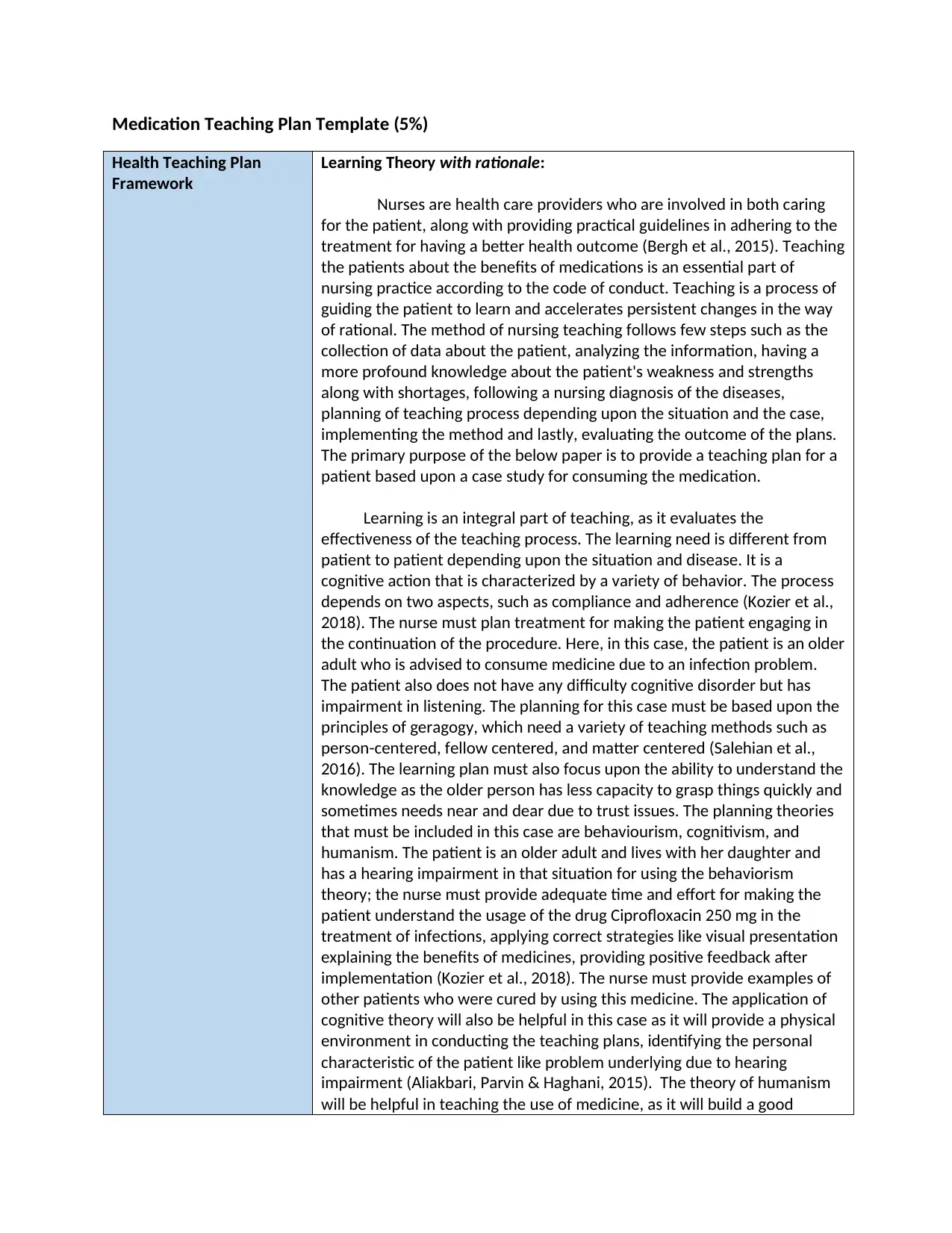
Medication Teaching Plan Template (5%)
Health Teaching Plan
Framework
Learning Theory with rationale:
Nurses are health care providers who are involved in both caring
for the patient, along with providing practical guidelines in adhering to the
treatment for having a better health outcome (Bergh et al., 2015). Teaching
the patients about the benefits of medications is an essential part of
nursing practice according to the code of conduct. Teaching is a process of
guiding the patient to learn and accelerates persistent changes in the way
of rational. The method of nursing teaching follows few steps such as the
collection of data about the patient, analyzing the information, having a
more profound knowledge about the patient's weakness and strengths
along with shortages, following a nursing diagnosis of the diseases,
planning of teaching process depending upon the situation and the case,
implementing the method and lastly, evaluating the outcome of the plans.
The primary purpose of the below paper is to provide a teaching plan for a
patient based upon a case study for consuming the medication.
Learning is an integral part of teaching, as it evaluates the
effectiveness of the teaching process. The learning need is different from
patient to patient depending upon the situation and disease. It is a
cognitive action that is characterized by a variety of behavior. The process
depends on two aspects, such as compliance and adherence (Kozier et al.,
2018). The nurse must plan treatment for making the patient engaging in
the continuation of the procedure. Here, in this case, the patient is an older
adult who is advised to consume medicine due to an infection problem.
The patient also does not have any difficulty cognitive disorder but has
impairment in listening. The planning for this case must be based upon the
principles of geragogy, which need a variety of teaching methods such as
person-centered, fellow centered, and matter centered (Salehian et al.,
2016). The learning plan must also focus upon the ability to understand the
knowledge as the older person has less capacity to grasp things quickly and
sometimes needs near and dear due to trust issues. The planning theories
that must be included in this case are behaviourism, cognitivism, and
humanism. The patient is an older adult and lives with her daughter and
has a hearing impairment in that situation for using the behaviorism
theory; the nurse must provide adequate time and effort for making the
patient understand the usage of the drug Ciprofloxacin 250 mg in the
treatment of infections, applying correct strategies like visual presentation
explaining the benefits of medicines, providing positive feedback after
implementation (Kozier et al., 2018). The nurse must provide examples of
other patients who were cured by using this medicine. The application of
cognitive theory will also be helpful in this case as it will provide a physical
environment in conducting the teaching plans, identifying the personal
characteristic of the patient like problem underlying due to hearing
impairment (Aliakbari, Parvin & Haghani, 2015). The theory of humanism
will be helpful in teaching the use of medicine, as it will build a good
Health Teaching Plan
Framework
Learning Theory with rationale:
Nurses are health care providers who are involved in both caring
for the patient, along with providing practical guidelines in adhering to the
treatment for having a better health outcome (Bergh et al., 2015). Teaching
the patients about the benefits of medications is an essential part of
nursing practice according to the code of conduct. Teaching is a process of
guiding the patient to learn and accelerates persistent changes in the way
of rational. The method of nursing teaching follows few steps such as the
collection of data about the patient, analyzing the information, having a
more profound knowledge about the patient's weakness and strengths
along with shortages, following a nursing diagnosis of the diseases,
planning of teaching process depending upon the situation and the case,
implementing the method and lastly, evaluating the outcome of the plans.
The primary purpose of the below paper is to provide a teaching plan for a
patient based upon a case study for consuming the medication.
Learning is an integral part of teaching, as it evaluates the
effectiveness of the teaching process. The learning need is different from
patient to patient depending upon the situation and disease. It is a
cognitive action that is characterized by a variety of behavior. The process
depends on two aspects, such as compliance and adherence (Kozier et al.,
2018). The nurse must plan treatment for making the patient engaging in
the continuation of the procedure. Here, in this case, the patient is an older
adult who is advised to consume medicine due to an infection problem.
The patient also does not have any difficulty cognitive disorder but has
impairment in listening. The planning for this case must be based upon the
principles of geragogy, which need a variety of teaching methods such as
person-centered, fellow centered, and matter centered (Salehian et al.,
2016). The learning plan must also focus upon the ability to understand the
knowledge as the older person has less capacity to grasp things quickly and
sometimes needs near and dear due to trust issues. The planning theories
that must be included in this case are behaviourism, cognitivism, and
humanism. The patient is an older adult and lives with her daughter and
has a hearing impairment in that situation for using the behaviorism
theory; the nurse must provide adequate time and effort for making the
patient understand the usage of the drug Ciprofloxacin 250 mg in the
treatment of infections, applying correct strategies like visual presentation
explaining the benefits of medicines, providing positive feedback after
implementation (Kozier et al., 2018). The nurse must provide examples of
other patients who were cured by using this medicine. The application of
cognitive theory will also be helpful in this case as it will provide a physical
environment in conducting the teaching plans, identifying the personal
characteristic of the patient like problem underlying due to hearing
impairment (Aliakbari, Parvin & Haghani, 2015). The theory of humanism
will be helpful in teaching the use of medicine, as it will build a good
Secure Best Marks with AI Grader
Need help grading? Try our AI Grader for instant feedback on your assignments.
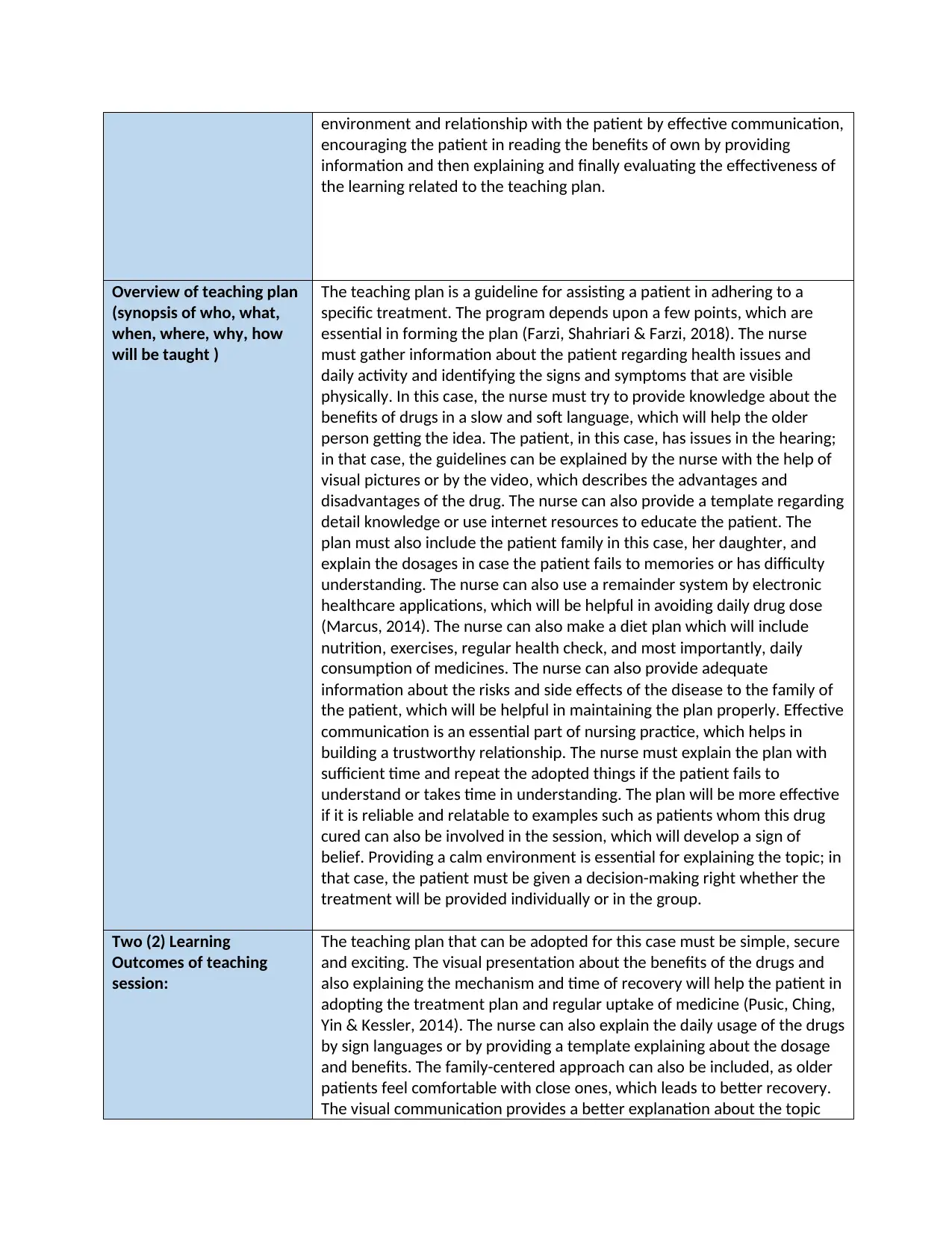
environment and relationship with the patient by effective communication,
encouraging the patient in reading the benefits of own by providing
information and then explaining and finally evaluating the effectiveness of
the learning related to the teaching plan.
Overview of teaching plan
(synopsis of who, what,
when, where, why, how
will be taught )
The teaching plan is a guideline for assisting a patient in adhering to a
specific treatment. The program depends upon a few points, which are
essential in forming the plan (Farzi, Shahriari & Farzi, 2018). The nurse
must gather information about the patient regarding health issues and
daily activity and identifying the signs and symptoms that are visible
physically. In this case, the nurse must try to provide knowledge about the
benefits of drugs in a slow and soft language, which will help the older
person getting the idea. The patient, in this case, has issues in the hearing;
in that case, the guidelines can be explained by the nurse with the help of
visual pictures or by the video, which describes the advantages and
disadvantages of the drug. The nurse can also provide a template regarding
detail knowledge or use internet resources to educate the patient. The
plan must also include the patient family in this case, her daughter, and
explain the dosages in case the patient fails to memories or has difficulty
understanding. The nurse can also use a remainder system by electronic
healthcare applications, which will be helpful in avoiding daily drug dose
(Marcus, 2014). The nurse can also make a diet plan which will include
nutrition, exercises, regular health check, and most importantly, daily
consumption of medicines. The nurse can also provide adequate
information about the risks and side effects of the disease to the family of
the patient, which will be helpful in maintaining the plan properly. Effective
communication is an essential part of nursing practice, which helps in
building a trustworthy relationship. The nurse must explain the plan with
sufficient time and repeat the adopted things if the patient fails to
understand or takes time in understanding. The plan will be more effective
if it is reliable and relatable to examples such as patients whom this drug
cured can also be involved in the session, which will develop a sign of
belief. Providing a calm environment is essential for explaining the topic; in
that case, the patient must be given a decision-making right whether the
treatment will be provided individually or in the group.
Two (2) Learning
Outcomes of teaching
session:
The teaching plan that can be adopted for this case must be simple, secure
and exciting. The visual presentation about the benefits of the drugs and
also explaining the mechanism and time of recovery will help the patient in
adopting the treatment plan and regular uptake of medicine (Pusic, Ching,
Yin & Kessler, 2014). The nurse can also explain the daily usage of the drugs
by sign languages or by providing a template explaining about the dosage
and benefits. The family-centered approach can also be included, as older
patients feel comfortable with close ones, which leads to better recovery.
The visual communication provides a better explanation about the topic
encouraging the patient in reading the benefits of own by providing
information and then explaining and finally evaluating the effectiveness of
the learning related to the teaching plan.
Overview of teaching plan
(synopsis of who, what,
when, where, why, how
will be taught )
The teaching plan is a guideline for assisting a patient in adhering to a
specific treatment. The program depends upon a few points, which are
essential in forming the plan (Farzi, Shahriari & Farzi, 2018). The nurse
must gather information about the patient regarding health issues and
daily activity and identifying the signs and symptoms that are visible
physically. In this case, the nurse must try to provide knowledge about the
benefits of drugs in a slow and soft language, which will help the older
person getting the idea. The patient, in this case, has issues in the hearing;
in that case, the guidelines can be explained by the nurse with the help of
visual pictures or by the video, which describes the advantages and
disadvantages of the drug. The nurse can also provide a template regarding
detail knowledge or use internet resources to educate the patient. The
plan must also include the patient family in this case, her daughter, and
explain the dosages in case the patient fails to memories or has difficulty
understanding. The nurse can also use a remainder system by electronic
healthcare applications, which will be helpful in avoiding daily drug dose
(Marcus, 2014). The nurse can also make a diet plan which will include
nutrition, exercises, regular health check, and most importantly, daily
consumption of medicines. The nurse can also provide adequate
information about the risks and side effects of the disease to the family of
the patient, which will be helpful in maintaining the plan properly. Effective
communication is an essential part of nursing practice, which helps in
building a trustworthy relationship. The nurse must explain the plan with
sufficient time and repeat the adopted things if the patient fails to
understand or takes time in understanding. The plan will be more effective
if it is reliable and relatable to examples such as patients whom this drug
cured can also be involved in the session, which will develop a sign of
belief. Providing a calm environment is essential for explaining the topic; in
that case, the patient must be given a decision-making right whether the
treatment will be provided individually or in the group.
Two (2) Learning
Outcomes of teaching
session:
The teaching plan that can be adopted for this case must be simple, secure
and exciting. The visual presentation about the benefits of the drugs and
also explaining the mechanism and time of recovery will help the patient in
adopting the treatment plan and regular uptake of medicine (Pusic, Ching,
Yin & Kessler, 2014). The nurse can also explain the daily usage of the drugs
by sign languages or by providing a template explaining about the dosage
and benefits. The family-centered approach can also be included, as older
patients feel comfortable with close ones, which leads to better recovery.
The visual communication provides a better explanation about the topic
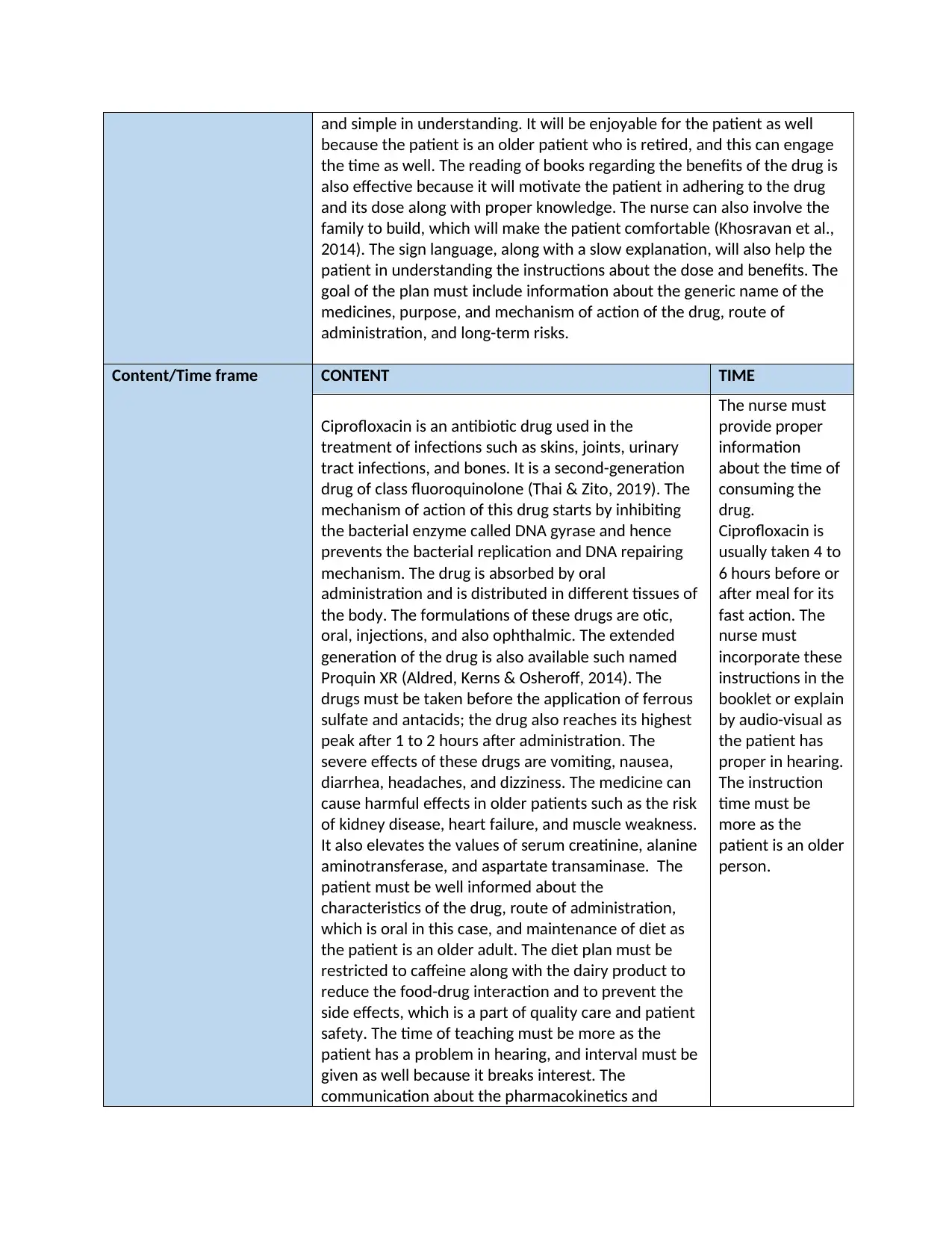
and simple in understanding. It will be enjoyable for the patient as well
because the patient is an older patient who is retired, and this can engage
the time as well. The reading of books regarding the benefits of the drug is
also effective because it will motivate the patient in adhering to the drug
and its dose along with proper knowledge. The nurse can also involve the
family to build, which will make the patient comfortable (Khosravan et al.,
2014). The sign language, along with a slow explanation, will also help the
patient in understanding the instructions about the dose and benefits. The
goal of the plan must include information about the generic name of the
medicines, purpose, and mechanism of action of the drug, route of
administration, and long-term risks.
Content/Time frame CONTENT TIME
Ciprofloxacin is an antibiotic drug used in the
treatment of infections such as skins, joints, urinary
tract infections, and bones. It is a second-generation
drug of class fluoroquinolone (Thai & Zito, 2019). The
mechanism of action of this drug starts by inhibiting
the bacterial enzyme called DNA gyrase and hence
prevents the bacterial replication and DNA repairing
mechanism. The drug is absorbed by oral
administration and is distributed in different tissues of
the body. The formulations of these drugs are otic,
oral, injections, and also ophthalmic. The extended
generation of the drug is also available such named
Proquin XR (Aldred, Kerns & Osheroff, 2014). The
drugs must be taken before the application of ferrous
sulfate and antacids; the drug also reaches its highest
peak after 1 to 2 hours after administration. The
severe effects of these drugs are vomiting, nausea,
diarrhea, headaches, and dizziness. The medicine can
cause harmful effects in older patients such as the risk
of kidney disease, heart failure, and muscle weakness.
It also elevates the values of serum creatinine, alanine
aminotransferase, and aspartate transaminase. The
patient must be well informed about the
characteristics of the drug, route of administration,
which is oral in this case, and maintenance of diet as
the patient is an older adult. The diet plan must be
restricted to caffeine along with the dairy product to
reduce the food-drug interaction and to prevent the
side effects, which is a part of quality care and patient
safety. The time of teaching must be more as the
patient has a problem in hearing, and interval must be
given as well because it breaks interest. The
communication about the pharmacokinetics and
The nurse must
provide proper
information
about the time of
consuming the
drug.
Ciprofloxacin is
usually taken 4 to
6 hours before or
after meal for its
fast action. The
nurse must
incorporate these
instructions in the
booklet or explain
by audio-visual as
the patient has
proper in hearing.
The instruction
time must be
more as the
patient is an older
person.
because the patient is an older patient who is retired, and this can engage
the time as well. The reading of books regarding the benefits of the drug is
also effective because it will motivate the patient in adhering to the drug
and its dose along with proper knowledge. The nurse can also involve the
family to build, which will make the patient comfortable (Khosravan et al.,
2014). The sign language, along with a slow explanation, will also help the
patient in understanding the instructions about the dose and benefits. The
goal of the plan must include information about the generic name of the
medicines, purpose, and mechanism of action of the drug, route of
administration, and long-term risks.
Content/Time frame CONTENT TIME
Ciprofloxacin is an antibiotic drug used in the
treatment of infections such as skins, joints, urinary
tract infections, and bones. It is a second-generation
drug of class fluoroquinolone (Thai & Zito, 2019). The
mechanism of action of this drug starts by inhibiting
the bacterial enzyme called DNA gyrase and hence
prevents the bacterial replication and DNA repairing
mechanism. The drug is absorbed by oral
administration and is distributed in different tissues of
the body. The formulations of these drugs are otic,
oral, injections, and also ophthalmic. The extended
generation of the drug is also available such named
Proquin XR (Aldred, Kerns & Osheroff, 2014). The
drugs must be taken before the application of ferrous
sulfate and antacids; the drug also reaches its highest
peak after 1 to 2 hours after administration. The
severe effects of these drugs are vomiting, nausea,
diarrhea, headaches, and dizziness. The medicine can
cause harmful effects in older patients such as the risk
of kidney disease, heart failure, and muscle weakness.
It also elevates the values of serum creatinine, alanine
aminotransferase, and aspartate transaminase. The
patient must be well informed about the
characteristics of the drug, route of administration,
which is oral in this case, and maintenance of diet as
the patient is an older adult. The diet plan must be
restricted to caffeine along with the dairy product to
reduce the food-drug interaction and to prevent the
side effects, which is a part of quality care and patient
safety. The time of teaching must be more as the
patient has a problem in hearing, and interval must be
given as well because it breaks interest. The
communication about the pharmacokinetics and
The nurse must
provide proper
information
about the time of
consuming the
drug.
Ciprofloxacin is
usually taken 4 to
6 hours before or
after meal for its
fast action. The
nurse must
incorporate these
instructions in the
booklet or explain
by audio-visual as
the patient has
proper in hearing.
The instruction
time must be
more as the
patient is an older
person.
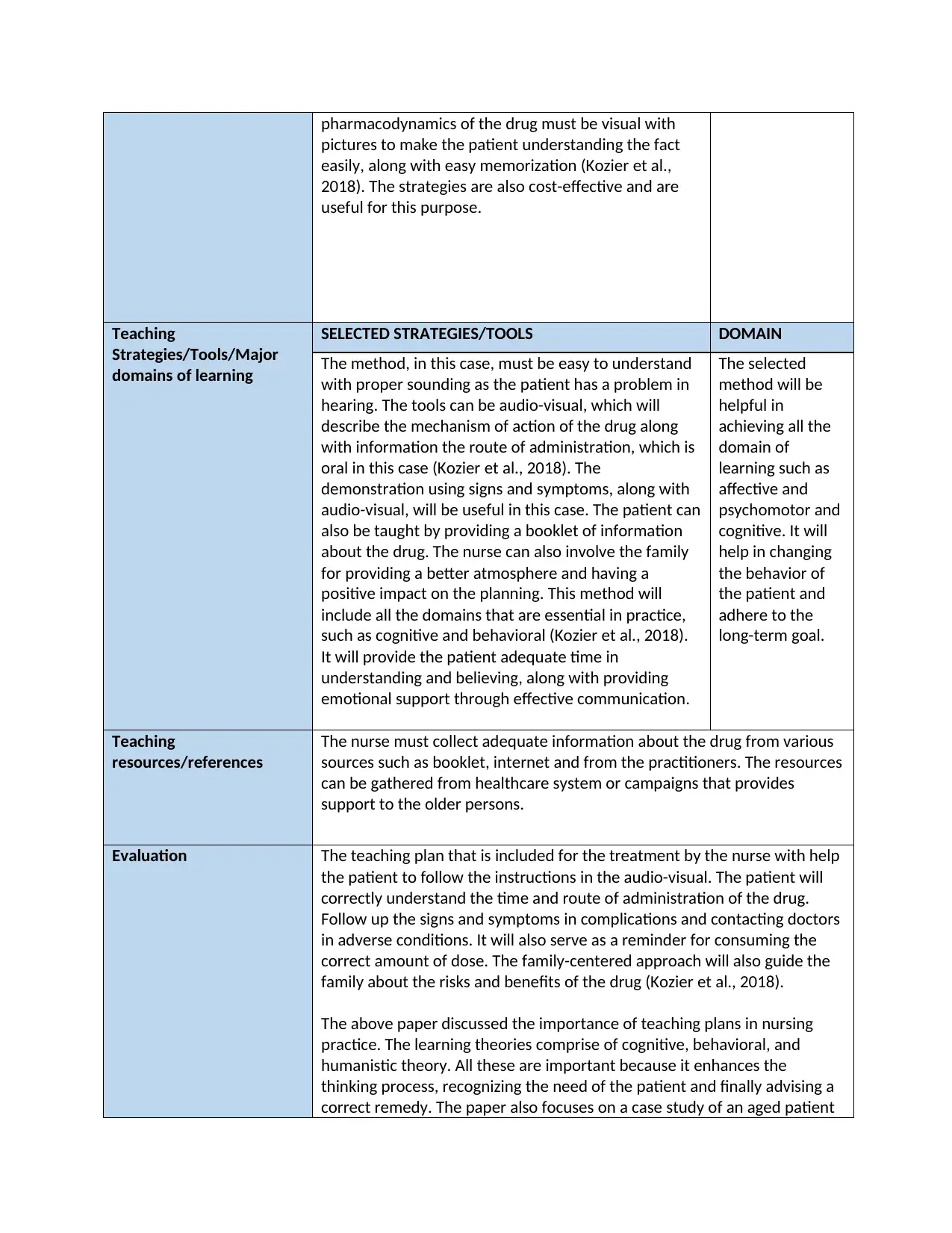
pharmacodynamics of the drug must be visual with
pictures to make the patient understanding the fact
easily, along with easy memorization (Kozier et al.,
2018). The strategies are also cost-effective and are
useful for this purpose.
Teaching
Strategies/Tools/Major
domains of learning
SELECTED STRATEGIES/TOOLS DOMAIN
The method, in this case, must be easy to understand
with proper sounding as the patient has a problem in
hearing. The tools can be audio-visual, which will
describe the mechanism of action of the drug along
with information the route of administration, which is
oral in this case (Kozier et al., 2018). The
demonstration using signs and symptoms, along with
audio-visual, will be useful in this case. The patient can
also be taught by providing a booklet of information
about the drug. The nurse can also involve the family
for providing a better atmosphere and having a
positive impact on the planning. This method will
include all the domains that are essential in practice,
such as cognitive and behavioral (Kozier et al., 2018).
It will provide the patient adequate time in
understanding and believing, along with providing
emotional support through effective communication.
The selected
method will be
helpful in
achieving all the
domain of
learning such as
affective and
psychomotor and
cognitive. It will
help in changing
the behavior of
the patient and
adhere to the
long-term goal.
Teaching
resources/references
The nurse must collect adequate information about the drug from various
sources such as booklet, internet and from the practitioners. The resources
can be gathered from healthcare system or campaigns that provides
support to the older persons.
Evaluation The teaching plan that is included for the treatment by the nurse with help
the patient to follow the instructions in the audio-visual. The patient will
correctly understand the time and route of administration of the drug.
Follow up the signs and symptoms in complications and contacting doctors
in adverse conditions. It will also serve as a reminder for consuming the
correct amount of dose. The family-centered approach will also guide the
family about the risks and benefits of the drug (Kozier et al., 2018).
The above paper discussed the importance of teaching plans in nursing
practice. The learning theories comprise of cognitive, behavioral, and
humanistic theory. All these are important because it enhances the
thinking process, recognizing the need of the patient and finally advising a
correct remedy. The paper also focuses on a case study of an aged patient
pictures to make the patient understanding the fact
easily, along with easy memorization (Kozier et al.,
2018). The strategies are also cost-effective and are
useful for this purpose.
Teaching
Strategies/Tools/Major
domains of learning
SELECTED STRATEGIES/TOOLS DOMAIN
The method, in this case, must be easy to understand
with proper sounding as the patient has a problem in
hearing. The tools can be audio-visual, which will
describe the mechanism of action of the drug along
with information the route of administration, which is
oral in this case (Kozier et al., 2018). The
demonstration using signs and symptoms, along with
audio-visual, will be useful in this case. The patient can
also be taught by providing a booklet of information
about the drug. The nurse can also involve the family
for providing a better atmosphere and having a
positive impact on the planning. This method will
include all the domains that are essential in practice,
such as cognitive and behavioral (Kozier et al., 2018).
It will provide the patient adequate time in
understanding and believing, along with providing
emotional support through effective communication.
The selected
method will be
helpful in
achieving all the
domain of
learning such as
affective and
psychomotor and
cognitive. It will
help in changing
the behavior of
the patient and
adhere to the
long-term goal.
Teaching
resources/references
The nurse must collect adequate information about the drug from various
sources such as booklet, internet and from the practitioners. The resources
can be gathered from healthcare system or campaigns that provides
support to the older persons.
Evaluation The teaching plan that is included for the treatment by the nurse with help
the patient to follow the instructions in the audio-visual. The patient will
correctly understand the time and route of administration of the drug.
Follow up the signs and symptoms in complications and contacting doctors
in adverse conditions. It will also serve as a reminder for consuming the
correct amount of dose. The family-centered approach will also guide the
family about the risks and benefits of the drug (Kozier et al., 2018).
The above paper discussed the importance of teaching plans in nursing
practice. The learning theories comprise of cognitive, behavioral, and
humanistic theory. All these are important because it enhances the
thinking process, recognizing the need of the patient and finally advising a
correct remedy. The paper also focuses on a case study of an aged patient
Secure Best Marks with AI Grader
Need help grading? Try our AI Grader for instant feedback on your assignments.
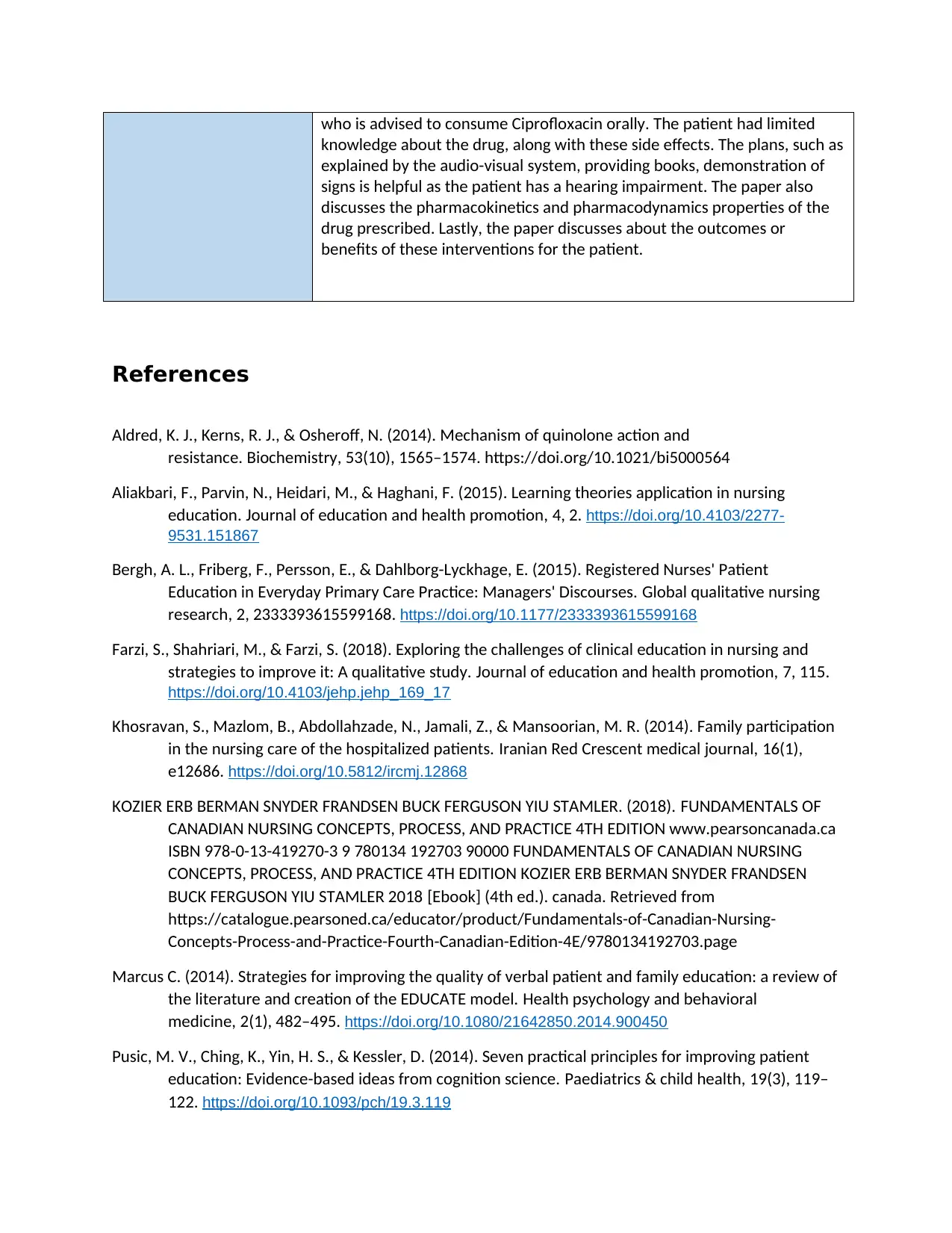
who is advised to consume Ciprofloxacin orally. The patient had limited
knowledge about the drug, along with these side effects. The plans, such as
explained by the audio-visual system, providing books, demonstration of
signs is helpful as the patient has a hearing impairment. The paper also
discusses the pharmacokinetics and pharmacodynamics properties of the
drug prescribed. Lastly, the paper discusses about the outcomes or
benefits of these interventions for the patient.
References
Aldred, K. J., Kerns, R. J., & Osheroff, N. (2014). Mechanism of quinolone action and
resistance. Biochemistry, 53(10), 1565–1574. https://doi.org/10.1021/bi5000564
Aliakbari, F., Parvin, N., Heidari, M., & Haghani, F. (2015). Learning theories application in nursing
education. Journal of education and health promotion, 4, 2. https://doi.org/10.4103/2277-
9531.151867
Bergh, A. L., Friberg, F., Persson, E., & Dahlborg-Lyckhage, E. (2015). Registered Nurses' Patient
Education in Everyday Primary Care Practice: Managers' Discourses. Global qualitative nursing
research, 2, 2333393615599168. https://doi.org/10.1177/2333393615599168
Farzi, S., Shahriari, M., & Farzi, S. (2018). Exploring the challenges of clinical education in nursing and
strategies to improve it: A qualitative study. Journal of education and health promotion, 7, 115.
https://doi.org/10.4103/jehp.jehp_169_17
Khosravan, S., Mazlom, B., Abdollahzade, N., Jamali, Z., & Mansoorian, M. R. (2014). Family participation
in the nursing care of the hospitalized patients. Iranian Red Crescent medical journal, 16(1),
e12686. https://doi.org/10.5812/ircmj.12868
KOZIER ERB BERMAN SNYDER FRANDSEN BUCK FERGUSON YIU STAMLER. (2018). FUNDAMENTALS OF
CANADIAN NURSING CONCEPTS, PROCESS, AND PRACTICE 4TH EDITION www.pearsoncanada.ca
ISBN 978-0-13-419270-3 9 780134 192703 90000 FUNDAMENTALS OF CANADIAN NURSING
CONCEPTS, PROCESS, AND PRACTICE 4TH EDITION KOZIER ERB BERMAN SNYDER FRANDSEN
BUCK FERGUSON YIU STAMLER 2018 [Ebook] (4th ed.). canada. Retrieved from
https://catalogue.pearsoned.ca/educator/product/Fundamentals-of-Canadian-Nursing-
Concepts-Process-and-Practice-Fourth-Canadian-Edition-4E/9780134192703.page
Marcus C. (2014). Strategies for improving the quality of verbal patient and family education: a review of
the literature and creation of the EDUCATE model. Health psychology and behavioral
medicine, 2(1), 482–495. https://doi.org/10.1080/21642850.2014.900450
Pusic, M. V., Ching, K., Yin, H. S., & Kessler, D. (2014). Seven practical principles for improving patient
education: Evidence-based ideas from cognition science. Paediatrics & child health, 19(3), 119–
122. https://doi.org/10.1093/pch/19.3.119
knowledge about the drug, along with these side effects. The plans, such as
explained by the audio-visual system, providing books, demonstration of
signs is helpful as the patient has a hearing impairment. The paper also
discusses the pharmacokinetics and pharmacodynamics properties of the
drug prescribed. Lastly, the paper discusses about the outcomes or
benefits of these interventions for the patient.
References
Aldred, K. J., Kerns, R. J., & Osheroff, N. (2014). Mechanism of quinolone action and
resistance. Biochemistry, 53(10), 1565–1574. https://doi.org/10.1021/bi5000564
Aliakbari, F., Parvin, N., Heidari, M., & Haghani, F. (2015). Learning theories application in nursing
education. Journal of education and health promotion, 4, 2. https://doi.org/10.4103/2277-
9531.151867
Bergh, A. L., Friberg, F., Persson, E., & Dahlborg-Lyckhage, E. (2015). Registered Nurses' Patient
Education in Everyday Primary Care Practice: Managers' Discourses. Global qualitative nursing
research, 2, 2333393615599168. https://doi.org/10.1177/2333393615599168
Farzi, S., Shahriari, M., & Farzi, S. (2018). Exploring the challenges of clinical education in nursing and
strategies to improve it: A qualitative study. Journal of education and health promotion, 7, 115.
https://doi.org/10.4103/jehp.jehp_169_17
Khosravan, S., Mazlom, B., Abdollahzade, N., Jamali, Z., & Mansoorian, M. R. (2014). Family participation
in the nursing care of the hospitalized patients. Iranian Red Crescent medical journal, 16(1),
e12686. https://doi.org/10.5812/ircmj.12868
KOZIER ERB BERMAN SNYDER FRANDSEN BUCK FERGUSON YIU STAMLER. (2018). FUNDAMENTALS OF
CANADIAN NURSING CONCEPTS, PROCESS, AND PRACTICE 4TH EDITION www.pearsoncanada.ca
ISBN 978-0-13-419270-3 9 780134 192703 90000 FUNDAMENTALS OF CANADIAN NURSING
CONCEPTS, PROCESS, AND PRACTICE 4TH EDITION KOZIER ERB BERMAN SNYDER FRANDSEN
BUCK FERGUSON YIU STAMLER 2018 [Ebook] (4th ed.). canada. Retrieved from
https://catalogue.pearsoned.ca/educator/product/Fundamentals-of-Canadian-Nursing-
Concepts-Process-and-Practice-Fourth-Canadian-Edition-4E/9780134192703.page
Marcus C. (2014). Strategies for improving the quality of verbal patient and family education: a review of
the literature and creation of the EDUCATE model. Health psychology and behavioral
medicine, 2(1), 482–495. https://doi.org/10.1080/21642850.2014.900450
Pusic, M. V., Ching, K., Yin, H. S., & Kessler, D. (2014). Seven practical principles for improving patient
education: Evidence-based ideas from cognition science. Paediatrics & child health, 19(3), 119–
122. https://doi.org/10.1093/pch/19.3.119
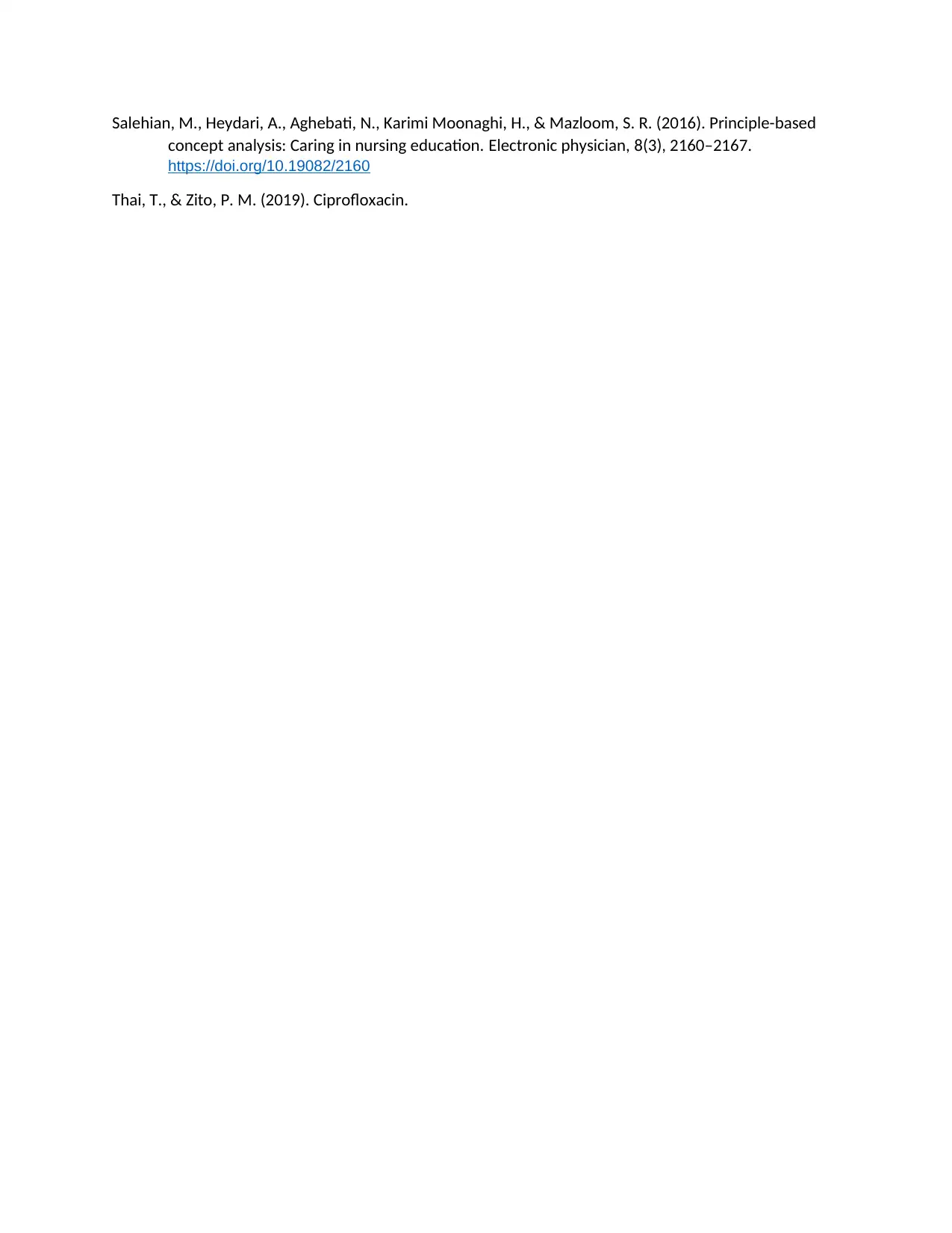
Salehian, M., Heydari, A., Aghebati, N., Karimi Moonaghi, H., & Mazloom, S. R. (2016). Principle-based
concept analysis: Caring in nursing education. Electronic physician, 8(3), 2160–2167.
https://doi.org/10.19082/2160
Thai, T., & Zito, P. M. (2019). Ciprofloxacin.
concept analysis: Caring in nursing education. Electronic physician, 8(3), 2160–2167.
https://doi.org/10.19082/2160
Thai, T., & Zito, P. M. (2019). Ciprofloxacin.
1 out of 6
Related Documents
Your All-in-One AI-Powered Toolkit for Academic Success.
+13062052269
info@desklib.com
Available 24*7 on WhatsApp / Email
![[object Object]](/_next/static/media/star-bottom.7253800d.svg)
Unlock your academic potential
© 2024 | Zucol Services PVT LTD | All rights reserved.





